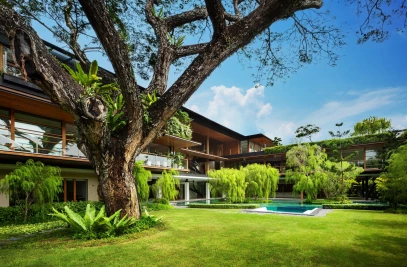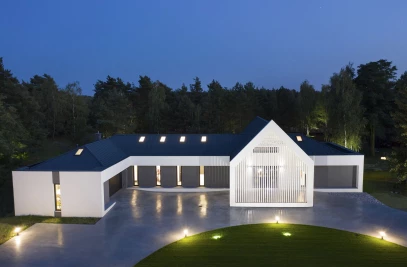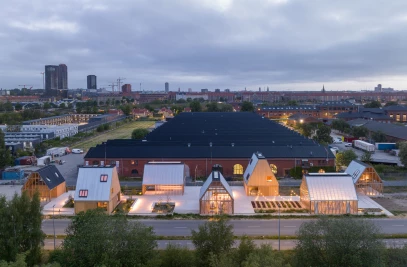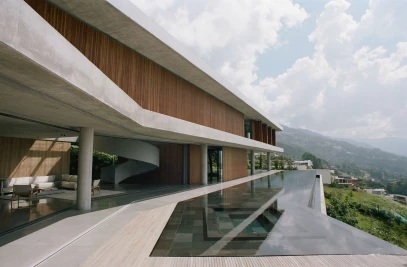The firms Site Practice and ZUS present the preliminary design for the Fritz District in Munich. A colossal, vacant office building will be transformed into a city district consisting of nine buildings and a varied public space; Pool Architekten, Robertneun and MAD Arkitekter are designing part of the buildings.
The Site Practice + ZUS team won the competition launched by Hines Real Estate and the City of Munich late last year for the transformation and expansion of the closed 1970s office building. Over the past six months, the firms have been working closely with the architects at Pool Architekten (Zurich), Robertneun (Berlin) and MAD Arkitekter (Oslo) as well as consultants and experts from the City of Munich to further develop the winning design.
Mixed urban area
The design offers a strategy to transform the monolithic office building into a multifunctional and urban area of some 75,000 m2, the Fritz District. By carefully cutting up the existing building, with as little demolition as possible, seven buildings are created. These are thickened and expanded into volumes that meet contemporary needs and requirements.
To this ensemble, the architects are adding two new buildings. The result is a varied composition of nine individual buildings, squares, alleys, courtyards, parks and (roof) terraces. The resulting diversity and multiformity allows for a diverse program, according to Site Practice + ZUS.
With its high urban density, Fritz District contributes to the revitalization of Neuperlach, a large-scale urban expansion from the 1960s. Fritz District should bring vibrancy to the city boulevard planned on the east side. This is also where the entrance to a central bicycle parking garage will be located. On the north side, the project anticipates the scaling down of the highway so that a sports park can be built there.
Public space
Five courtyards largely define the public space; each one focuses on a different aspect of the district, the designers explain. At the heart is the 'market square' with sheltered terraces adjacent to it. Next to it is the 'private courtyard' that provides space for nature and play. Combined with the eastern entrance to the district, the 'makers square' provides space for local economy.
To the north are the 'secret court' and the 'cultural court,' which respectively provide space for urban nature and activities such as an outdoor cinema. A system of alleys and fords connect the courts.
The plinths of all nine buildings provide the lively character of the urban microcosm and, for example, provide space for already present, successful initiatives, such as the Community Kitchen. All buildings stand with an arcade in the public space, providing a gradual transition between outside and inside.
Reuse and recognizability
In addition to maximizing the reuse of the existing building, the design team aims to repurpose all existing materials, such as the existing natural stone facade slabs and window frames, in the new district. All new construction, additions and additions will be realized in hybrid wood structures, says Site Practice + ZUS, further reducing the carbon footprint.
The collective of architects jointly developed a catalog of the key materials and features of the former office building. From this they drew for the various building designs. In intensive collaboration - and inspired by Bauhaus - the firms have sought a language that does justice to the original architecture, the team says.
Each building derives its formal language and pattern from the existing complex - including the characteristic 45-degree angle. By designing from both the individual buildings and the district as a whole, a cohesive composition forms: a cohesive "family of buildings. The buildings were distributed among the offices involved in such a way as to create a mix between the different "design dialects.
Fritz
Each building was named Fritz with a number. The master plan, public space and Fritz 1, 6, 9 were designed by Site Practice + ZUS. Fritz 2 and 4 are a design by Robertneun, MAD Arkitekter designed Fritz 3 and 5 and Pool Architects drew Fritz 7-8.
Fritz 1 is the corner building on the boulevard. The design is grafted onto the existing C-shaped office wing, fitted with an addition in the form of a turned cube. Thickening the building's plinth to the south creates maker spaces for local entrepreneurs with a large green rooftop park above for residents. A daycare center is planned on the corner with housing above. The whole is folded around a green court.
On the walkway connecting the district to the center of Neuperlach is the Fritz 2 gatehouse. In the plinth of this new wooden residential building is the entrance to the central parking garage and a "mobility shop. Next to the large staircase with water square is the entrance to the apartments in the building. The design plays with the 45 degrees by rotating the floor plans and outdoor spaces, creating a characteristic facade appearance.
Fritz 3, 4 and 5
The already existing Community Kitchen is given a new location in Fritz 3, giving it a central character. Its location on the Neuperline, the lifted bridge connection, gives the plinth an all-round public character. Much of the existing building remains legible in the volume, and the wooden topping also reinterprets the pattern of the original building. On the lower floors will be workspaces, above which are dwellings with panoramic views.
On the north side is Fritz 4, an office building as a second gateway building. Powerfully leaning over, it makes a welcoming gesture. In the plinth is space for sports facilities, connecting the building to the planned sports park on the north side. Together with Fritz 5 and 6, this office building also serves as a noise barrier for the highway to the north.
Fritz 5 makes a strong connection to the "culture court" by combining the entrance with a grandstand. Here residents and visitors can watch performances in the court. Characteristic features of the building are the jagged facade with green window frames and the stepped roof, which offers views of the nearby Alps with several terraces. The building, situated between higher volumes, has primarily an office program.
Fritz 6, 7 and 8.
At the northeast corner of the district, Fritz 6 forms a height accent. The new building consists of two interlocking volumes that represent the turn of the entire complex, according to the design team. The volume mediates between the space on the north side in favor of the existing trees and the space for the "secret court. This office building will be built entirely in wood, with the structure becoming recognizable in the façade composition.
The two former office wings, which will form Fritz 7 and 8, are connected by the addition of a large beam across the building. This also creates a grand entrance to the district on the east side. The various volumes provide space for a variety of residential forms; the plinth provides space for entrepreneurs, connecting to the 'makers court'. Collective sports and swimming facilities are located on the roof.
Fritz 9: cultural heart
In the heart of the district lies Fritz 9. The exposed circulation core of the former office complex will be given a cultural destination and, as a three-dimensional public space, will accommodate existing and new local initiatives. An external circulation makes the building experienceable from all sides.
The semi-air-conditioned outdoor space is interspersed with units for the establishment of start-ups and neighborhood facilities. The first floor will have a double-height ceiling as part of the public space, while a small theater with a terrace is planned on the roof.



![photo_credit Site Practice, ZUS[Zones Urbaines Sensibles] photo_credit Site Practice, ZUS[Zones Urbaines Sensibles]](https://archello.s3.eu-central-1.amazonaws.com/images/2023/08/03/Architectenweb---Site-Practice---ZUS-presenteert-voorlopig-ontwerp-Fritz-District-M--nchen---Beeld-4---Copyright-Site-Practice--ZUS-Zones-Urbaines-Sensibles-.1691057801.9934.jpg)




![photo_credit Site Practice, ZUS[Zones Urbaines Sensibles] photo_credit Site Practice, ZUS[Zones Urbaines Sensibles]](https://archello.s3.eu-central-1.amazonaws.com/images/2023/08/03/Architectenweb---Site-Practice---ZUS-presenteert-voorlopig-ontwerp-Fritz-District-M--nchen---Beeld-8---Copyright-Site-Practice--ZUS-Zones-Urbaines-Sensibles-.1691057805.399.jpg)
![photo_credit Site Practice, ZUS[Zones Urbaines Sensibles] photo_credit Site Practice, ZUS[Zones Urbaines Sensibles]](https://archello.s3.eu-central-1.amazonaws.com/images/2023/08/03/Architectenweb---Site-Practice---ZUS-presenteert-voorlopig-ontwerp-Fritz-District-M--nchen---Beeld-7---Copyright-Site-Practice--ZUS-Zones-Urbaines-Sensibles-.1691057804.3092.jpg)
![photo_credit Site Practice, ZUS[Zones Urbaines Sensibles], Pool Architekten, Robertneun, MAD arkitekten photo_credit Site Practice, ZUS[Zones Urbaines Sensibles], Pool Architekten, Robertneun, MAD arkitekten](https://archello.s3.eu-central-1.amazonaws.com/images/2023/08/03/Architectenweb---Site-Practice---ZUS-presenteert-voorlopig-ontwerp-Fritz-District-M--nchen---Beeld-6---Copyright-Site-Practice--ZUS-Zones-Urbaines-Sensibles---Pool-Architekten--Robertneun--MAD-arkitekten.1691057803.4119.jpg)








![Architectenweb - Site Practice + ZUS presenteert voorlopig ontwerp Fritz District München - Beeld 3 - Copyright Site Practice, ZUS[Zones Urbaines Sensibles].jpg Architectenweb - Site Practice + ZUS presenteert voorlopig ontwerp Fritz District München - Beeld 3 - Copyright Site Practice, ZUS[Zones Urbaines Sensibles].jpg](https://archello.com/thumbs/images/2023/08/03/Architectenweb---Site-Practice---ZUS-presenteert-voorlopig-ontwerp-Fritz-District-M--nchen---Beeld-3---Copyright-Site-Practice--ZUS-Zones-Urbaines-Sensibles-.1691057801.3142.jpg?fit=crop&w=203&h=136)
![Architectenweb - Site Practice + ZUS presenteert voorlopig ontwerp Fritz District München - Beeld 4 - Copyright Site Practice, ZUS[Zones Urbaines Sensibles].jpg Architectenweb - Site Practice + ZUS presenteert voorlopig ontwerp Fritz District München - Beeld 4 - Copyright Site Practice, ZUS[Zones Urbaines Sensibles].jpg](https://archello.com/thumbs/images/2023/08/03/Architectenweb---Site-Practice---ZUS-presenteert-voorlopig-ontwerp-Fritz-District-M--nchen---Beeld-4---Copyright-Site-Practice--ZUS-Zones-Urbaines-Sensibles-.1691057801.9934.jpg?fit=crop&w=203&h=136)
![Architectenweb - Site Practice + ZUS presenteert voorlopig ontwerp Fritz District München - Beeld 5 - Copyright Site Practice, ZUS[Zones Urbaines Sensibles].jpg Architectenweb - Site Practice + ZUS presenteert voorlopig ontwerp Fritz District München - Beeld 5 - Copyright Site Practice, ZUS[Zones Urbaines Sensibles].jpg](https://archello.com/thumbs/images/2023/08/03/Architectenweb---Site-Practice---ZUS-presenteert-voorlopig-ontwerp-Fritz-District-M--nchen---Beeld-5---Copyright-Site-Practice--ZUS-Zones-Urbaines-Sensibles-.1691057802.7653.jpg?fit=crop&w=203&h=136)
![Architectenweb - Site Practice + ZUS presenteert voorlopig ontwerp Fritz District München - Beeld 6 - Copyright Site Practice, ZUS[Zones Urbaines Sensibles], Pool Architekten, Robertneun, MAD arkitekten.jpg Architectenweb - Site Practice + ZUS presenteert voorlopig ontwerp Fritz District München - Beeld 6 - Copyright Site Practice, ZUS[Zones Urbaines Sensibles], Pool Architekten, Robertneun, MAD arkitekten.jpg](https://archello.com/thumbs/images/2023/08/03/Architectenweb---Site-Practice---ZUS-presenteert-voorlopig-ontwerp-Fritz-District-M--nchen---Beeld-6---Copyright-Site-Practice--ZUS-Zones-Urbaines-Sensibles---Pool-Architekten--Robertneun--MAD-arkitekten.1691057803.4119.jpg?fit=crop&w=203&h=136)
![Architectenweb - Site Practice + ZUS presenteert voorlopig ontwerp Fritz District München - Beeld 7 - Copyright Site Practice, ZUS[Zones Urbaines Sensibles].jpg Architectenweb - Site Practice + ZUS presenteert voorlopig ontwerp Fritz District München - Beeld 7 - Copyright Site Practice, ZUS[Zones Urbaines Sensibles].jpg](https://archello.com/thumbs/images/2023/08/03/Architectenweb---Site-Practice---ZUS-presenteert-voorlopig-ontwerp-Fritz-District-M--nchen---Beeld-7---Copyright-Site-Practice--ZUS-Zones-Urbaines-Sensibles-.1691057804.3092.jpg?fit=crop&w=203&h=136)
![Architectenweb - Site Practice + ZUS presenteert voorlopig ontwerp Fritz District München - Beeld 8 - Copyright Site Practice, ZUS[Zones Urbaines Sensibles].jpg Architectenweb - Site Practice + ZUS presenteert voorlopig ontwerp Fritz District München - Beeld 8 - Copyright Site Practice, ZUS[Zones Urbaines Sensibles].jpg](https://archello.com/thumbs/images/2023/08/03/Architectenweb---Site-Practice---ZUS-presenteert-voorlopig-ontwerp-Fritz-District-M--nchen---Beeld-8---Copyright-Site-Practice--ZUS-Zones-Urbaines-Sensibles-.1691057805.399.jpg?fit=crop&w=203&h=136)
![Architectenweb - Site Practice + ZUS presenteert voorlopig ontwerp Fritz District München - Beeld 9 - Copyright Site Practice, ZUS[Zones Urbaines Sensibles].jpg Architectenweb - Site Practice + ZUS presenteert voorlopig ontwerp Fritz District München - Beeld 9 - Copyright Site Practice, ZUS[Zones Urbaines Sensibles].jpg](https://archello.com/thumbs/images/2023/08/03/Architectenweb---Site-Practice---ZUS-presenteert-voorlopig-ontwerp-Fritz-District-M--nchen---Beeld-9---Copyright-Site-Practice--ZUS-Zones-Urbaines-Sensibles-.1691057806.5934.jpg?fit=crop&w=203&h=136)























